
Rail transportation company Greenbrier (NYSE: GBX) announced better-than-expected revenue in Q4 CY2024, with sales up 8.3% year on year to $875.9 million. On the other hand, the company’s full-year revenue guidance of $3.5 billion at the midpoint came in 1.2% below analysts’ estimates. Its GAAP profit of $1.70 per share was 47.2% above analysts’ consensus estimates.
Is now the time to buy Greenbrier? Find out by accessing our full research report, it’s free.
Greenbrier (GBX) Q4 CY2024 Highlights:
- Revenue: $875.9 million vs analyst estimates of $849.5 million (8.3% year-on-year growth, 3.1% beat)
- Adjusted EPS: $1.70 vs analyst estimates of $1.16 (47.2% beat)
- Adjusted EBITDA: $145.1 million vs analyst estimates of $109.3 million (16.6% margin, 32.8% beat)
- The company reconfirmed its revenue guidance for the full year of $3.5 billion at the midpoint
- Operating Margin: 12.8%, up from 8% in the same quarter last year
- Free Cash Flow was -$124.2 million compared to -$113 million in the same quarter last year
- Sales Volumes fell 25.5% year on year and missed expectations (-8.9% in the same quarter last year)
- Market Capitalization: $1.89 billion
Company Overview
Having designed the industry’s first double-decker railcar in the 1980s, Greenbrier (NYSE: GBX) supplies the freight rail transportation industry with railcars and related services.
Heavy Transportation Equipment
Heavy transportation equipment companies are investing in automated vehicles that increase efficiencies and connected machinery that collects actionable data. Some are also developing electric vehicles and mobility solutions to address customers’ concerns about carbon emissions, creating new sales opportunities. Additionally, they are increasingly offering automated equipment that increases efficiencies and connected machinery that collects actionable data. On the other hand, heavy transportation equipment companies are at the whim of economic cycles. Interest rates, for example, can greatly impact the construction and transport volumes that drive demand for these companies’ offerings.
Sales Growth
A company’s long-term sales performance signals its overall quality. Even a bad business can shine for one or two quarters, but a top-tier one grows for years. Over the last five years, Greenbrier grew its sales at a sluggish 2.5% compounded annual growth rate. This fell short of our benchmarks and is a tough starting point for our analysis.
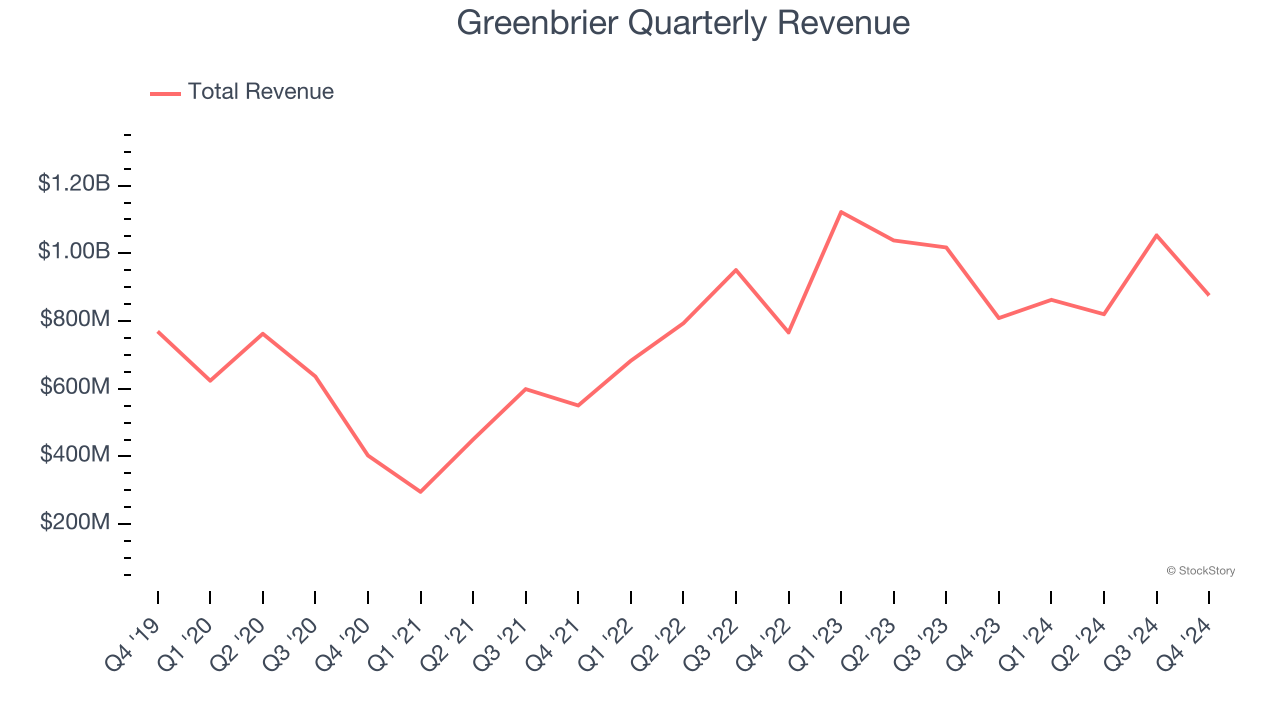
We at StockStory place the most emphasis on long-term growth, but within industrials, a half-decade historical view may miss cycles, industry trends, or a company capitalizing on catalysts such as a new contract win or a successful product line. Greenbrier’s annualized revenue growth of 6.3% over the last two years is above its five-year trend, but we were still disappointed by the results. We also note many other Heavy Transportation Equipment businesses have faced declining sales because of cyclical headwinds. While Greenbrier grew slower than we’d like, it did perform better than its peers. 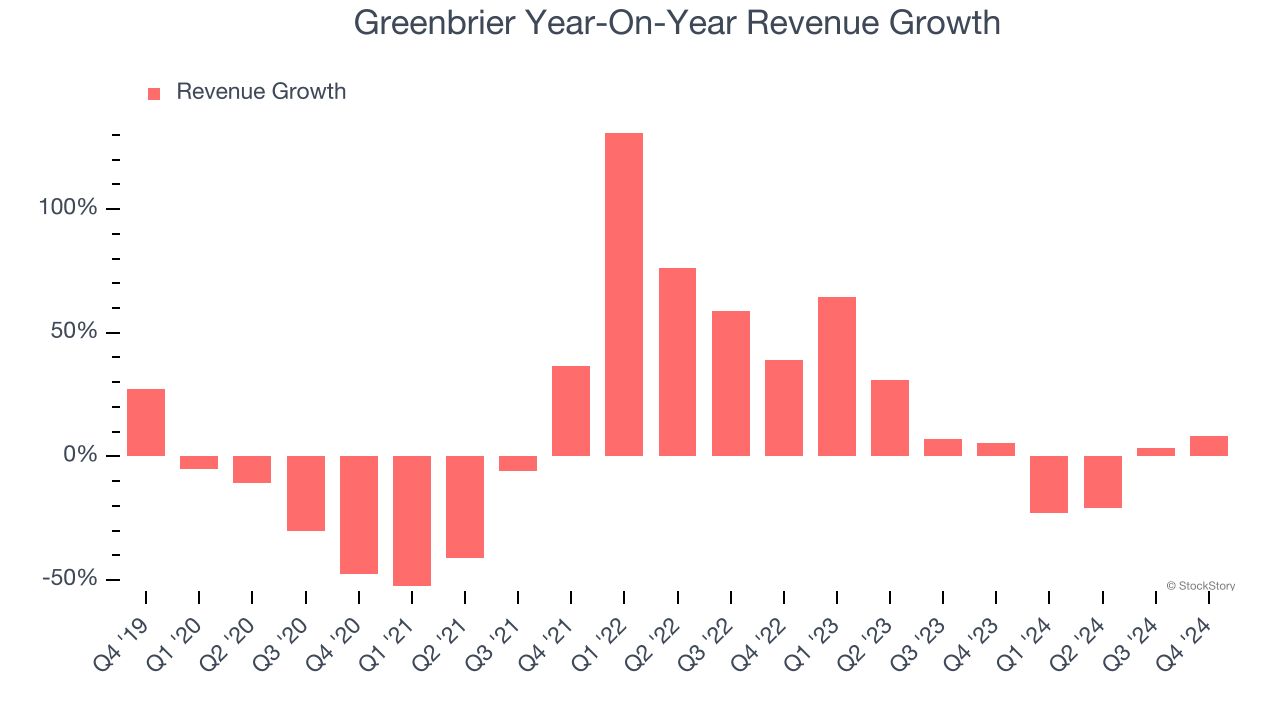
We can better understand the company’s revenue dynamics by analyzing its units sold, which reached 3,800 in the latest quarter. Over the last two years, Greenbrier’s units sold averaged 15.8% year-on-year growth. Because this number is better than its revenue growth, we can see the company’s average selling price decreased. 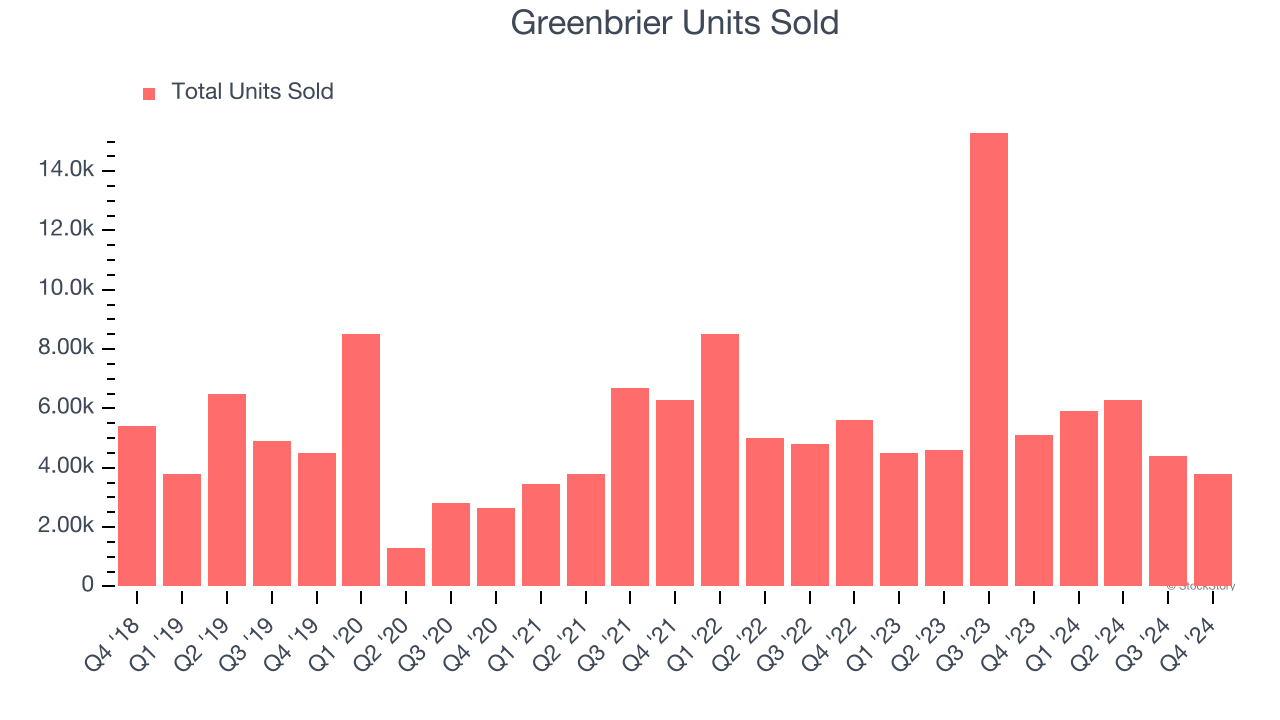
This quarter, Greenbrier reported year-on-year revenue growth of 8.3%, and its $875.9 million of revenue exceeded Wall Street’s estimates by 3.1%.
We also like to judge companies based on their projected revenue growth, but not enough Wall Street analysts cover the company for it to have reliable consensus estimates.
Here at StockStory, we certainly understand the potential of thematic investing. Diverse winners from Microsoft (MSFT) to Alphabet (GOOG), Coca-Cola (KO) to Monster Beverage (MNST) could all have been identified as promising growth stories with a megatrend driving the growth. So, in that spirit, we’ve identified a relatively under-the-radar profitable growth stock benefiting from the rise of AI, available to you FREE via this link.
Operating Margin
Operating margin is an important measure of profitability as it shows the portion of revenue left after accounting for all core expenses–everything from the cost of goods sold to advertising and wages. It’s also useful for comparing profitability across companies with different levels of debt and tax rates because it excludes interest and taxes.
Greenbrier was profitable over the last five years but held back by its large cost base. Its average operating margin of 5.9% was weak for an industrials business. This result isn’t too surprising given its low gross margin as a starting point.
On the plus side, Greenbrier’s operating margin rose by 5.1 percentage points over the last five years.
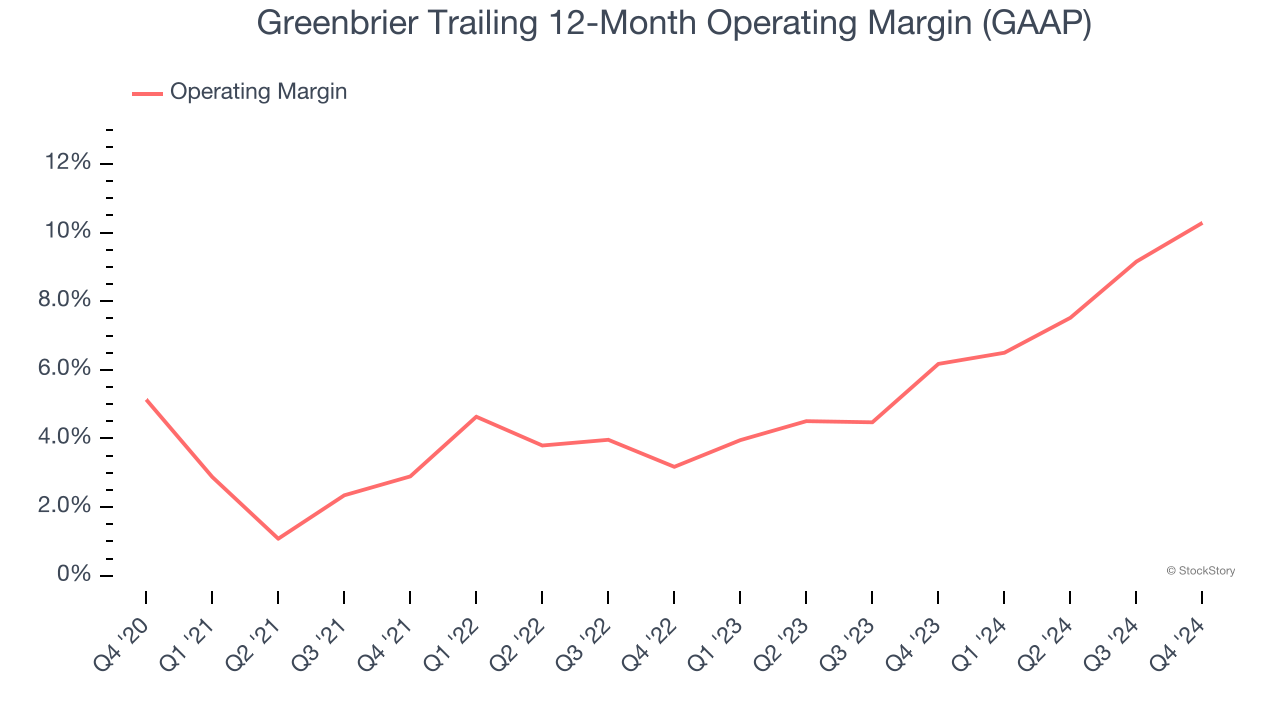
In Q4, Greenbrier generated an operating profit margin of 12.8%, up 4.7 percentage points year on year. Since its gross margin expanded more than its operating margin, we can infer that leverage on its cost of sales was the primary driver behind the recently higher efficiency.
Earnings Per Share
We track the long-term change in earnings per share (EPS) for the same reason as long-term revenue growth. Compared to revenue, however, EPS highlights whether a company’s growth is profitable.
Greenbrier’s EPS grew at an astounding 25.5% compounded annual growth rate over the last five years, higher than its 2.5% annualized revenue growth. This tells us the company became more profitable on a per-share basis as it expanded.
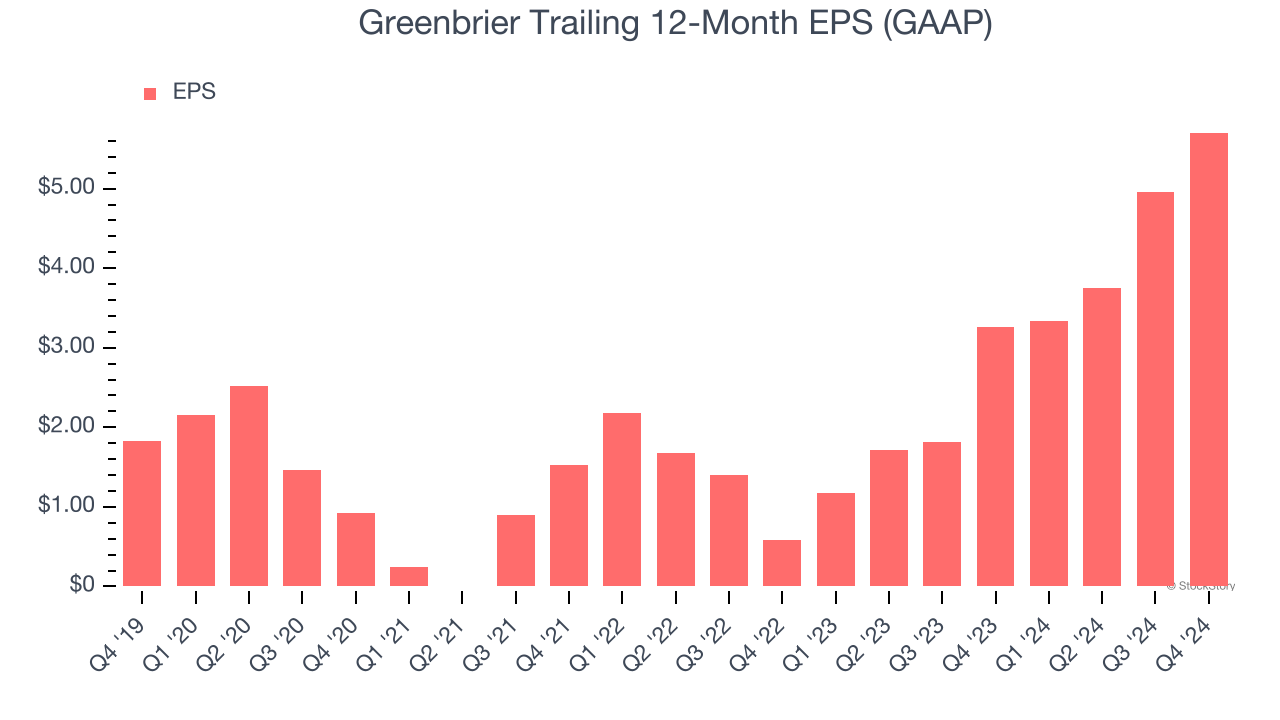
Diving into the nuances of Greenbrier’s earnings can give us a better understanding of its performance. As we mentioned earlier, Greenbrier’s operating margin expanded by 5.1 percentage points over the last five years. On top of that, its share count shrank by 3.2%. These are positive signs for shareholders because improving profitability and share buybacks turbocharge EPS growth relative to revenue growth. 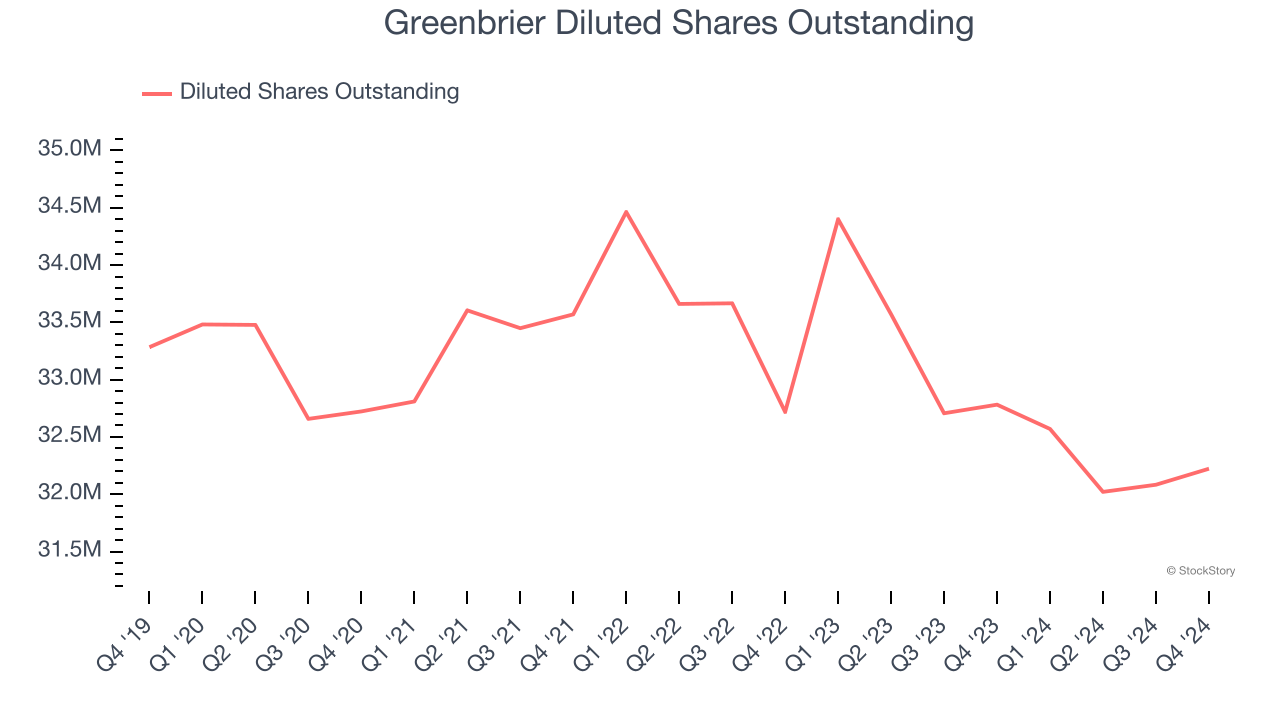
Like with revenue, we analyze EPS over a shorter period to see if we are missing a change in the business.
For Greenbrier, its two-year annual EPS growth of 213% was higher than its five-year trend. We love it when earnings growth accelerates, especially when it accelerates off an already high base.In Q4, Greenbrier reported EPS at $1.70, up from $0.95 in the same quarter last year. This print easily cleared analysts’ estimates, and shareholders should be content with the results. We also like to analyze expected EPS growth based on Wall Street analysts’ consensus projections, but there is insufficient data.
Key Takeaways from Greenbrier’s Q4 Results
We were impressed by how significantly Greenbrier blew past analysts’ EBITDA and EPS expectations this quarter. On the other hand, its sales volume missed and its full-year revenue guidance, which was maintained, fell slightly short of Wall Street’s estimates. Overall, this quarter was mixed but the higher-than-expected profitability in the quarter is a bright spot. The stock remained flat at $60.45 immediately after reporting.
Is Greenbrier an attractive investment opportunity at the current price? What happened in the latest quarter matters, but not as much as longer-term business quality and valuation, when deciding whether to invest in this stock. We cover that in our actionable full research report which you can read here, it’s free.





